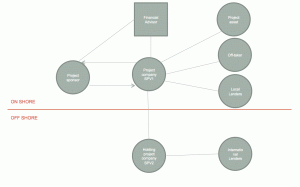Renewable Energy Projects in sub-Saharan Africa
Proprietary know-how to NPL Advisors
Part I
A critical factor in successfully closing a renewable energy project in sub-Saharan Africa is the development of a financing structure that will (i) be sufficiently attractive to international lenders and/or to investors from a legal, regulatory, tax, accounting and yield (ROE/ROI) perspective; and (ii) address the particular needs and terrain (both geographical and financial) of the relevant African project sponsor.
In the world of structured finance there are various models that have been used for structuring renewables projects but the most apt would be a model based on project finance (as opposed to a model based on the creditworthiness of the relevant ‘Borrower’ or Project company).This case study will explore the former model with a view of demystifying the concept ; expounding the structure in a clear and open manner; and finally, seeing how it can and should be adapted to suit the specific needs of project companies in developing economies who typically find this form of financing challenging giving that it is usually their first time in engaging in cross border/multi-jurisdictional project finance.

This type of renewables project will be financed on a limited recourse basis meaning that the Onshore project company (referred to in the diagram above as Project company SPV1 (‘SPV1)) will only be liable to existing and future Creditors and Investors to the extent it has assets and readily available cash/ revenue stream on its balance sheet.
Typically both the Onshore and Offshore financing vehicles are set up as special purpose entities (‘Spv’); that is to say, they are “bankruptcy remote” corporate vehicles which have been established for the sole purpose of transacting on the project. In addition to this, the Offshore Spv (Holding project company SPV2 (‘SPV2’) in the diagram above) will be set up as a holding company of SPV1. The reasons for structuring the project in this manner are as follows:
- SPV2 will be set up in a tax efficient “clean” jurisdiction, such as Mauritius or Dublin, where investors are familiar with the legal and regulatory requirements;
- there are favourable double taxation treaties in place between these jurisdictions and the onshore local jurisdiction of SPV1 e.g. mitigation on rate of withholding tax and other tax emption certificates are permissible thereby making the structure more tax efficient; and
- in the event that SPV1 defaults on any of its material obligation(s) thereby triggering an Event of Default, there will be no need for its creditors and/or any foreign investor(s) to have to enforce onshore as their recourse will be to the offshore holding company SPV2. This gives additional security and comfort to first time investors unfamiliar with investing in the African continent.
Step 1
The Project sponsor (i.e. the parent or relevant developer or sponsor) establishes SPV 1 in its home jurisdiction in sub-Saharan Africa; SPV 1 will construct and operate the project. Concurrently with this, the Project sponsor also establishes SPV2 which in view of its holding in SPV1 should own 100% of the project. The Project sponsor, as an equity holder in SPV1 and/or SPV2 will not be liable for the obligations of either SPV1 and/or SPV2 unless it contractually agrees to such liability, is negotiated and clearly defined, typically in a Creditors’ Intercreditor Agreement.
Step 2
SPV1 obtains control of the construction and facility site by entering into a long-term lease, or purchase, of the site. All of SPV 1’s current/existing and future rights and interest in the project are charged for the sole benefit of SPV2 (subject to any legal, contractually negotiated and/or statutory preferred creditors).
Step 3
SPV 1 enters into one or more construction contracts with a contractor to procure the equipment for, and construction and installation of, the facility.
Step 4
SPV 1 enters into (1) an off-take agreement or power purchase agreement (“PPA”) to sell its output (such as biofuel or electricity) to a creditworthy third party (ies) (usually a utility or commercial customer(s)); and (2) a feedstock supply agreement to acquire the necessary fuel (unless of course the project is solar, wind or geothermal, where the fuel need not to be purchased).
Step 5
SPV1 will not have its own employees so it enters into an operations and maintenance agreement (commonly referred to as an ‘O&M Agreement’), and often an asset management agreement, to provide for necessary services to be performed for SPV1. The agreements are often with professional/expert third parties who are in the business of operating similar facilities.
Step 6
SPV1 and/or SPV 2 enter into a credit agreement with one or more lender(s) (often through one bank acting as an agent). The lender group will rely on reports of independent professional third party service providers and consultants in performing its due diligence.
Step 7
One or more additional equity investor(s) may be admitted to SPV1 and/or SPV2 in order to provide equity or debt funding (as may be required) or indeed desired by the relevant Project sponsor.
Part II
Part II of this Case Study entitled “Funding” will be made available on request. Please contact NPL Advisors.
